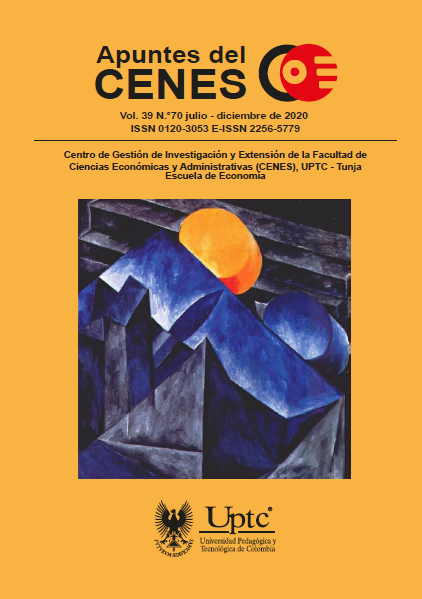Determinants of Trade Flows between Colombia and South Korea

Abstract
This paper identifies the determinants of trade flows between Colombia and South Korea. For this purpose, the economic and commercial profile for both countries, bilateral trade and the signed FTA were analyzed. Likewise, a gravity model for total and sectorial trade with panel data for the period of 1993-2013 is applied, finding consistencies with the theoretical postulates. Variables such as income of the importer and exporter countries determine positive and significant bilateral trade, while the distance and landlocked decrease the likelihood of trade. Furthermore, the results of the gravity model indicate that the free trade agreements have no significant impact on trade of South Korea; however, from the analysis of the agreement it is considered that Colombian agricultural and agro-industrial products have potential opportunities to compete in the Asian country.
Keywords
bilateral trade; gravity model; free trade agreement; Colombia; South Korea;
References
1. Anaman, K. & Al-Kharusi, L. (2003). An Analysis of Trade Flows between Brunei Darussalam and the European Union. ASEAN Economic Bulletin, 20, 60-72. https://doi.org/10.1355/AE20-1E
2. Anderson, J. & Van Wincoop, E. (2003). Gravity with Gravitas: A Solution to the Border Puzzle. The American Economic Review, 93, 170-192. https://doi.org/10.1257/000282803321455214
3. Bergstrand, J. (1985). The Gravity Equation in International Trade: Some Microeconomic Foundations and Empirical Evidence. The Review of Economics and Statistics, 67, 474-481. https://doi.org/10.2307/1925976
4. Bergstrand, J. (1989). The generalized gravity equation, monopolistic competition, and the factor-proportions theory in international trade. The Review of Economics and Statistics, 71, 143-153. https://doi.org/10.2307/1928061
5. Centro de Investigaciones para el Desarrollo (CID). (2007). Impacto del TLC en el departamento de Cundinamarca. CID.
6. Congreso de la República de Colombia. (2014, 26 de dic.). Ley 174 de 2012. Por medio de la cual se aprueba el Acuerdo de libre comercio entre la República de Colombia y la República de Corea. http://www.tlc.gov.co/publicaciones/733/acuerdode_libre_comercio_entre_la_republica_de_colombia_y_la_republica_de_corea
7. Deardorff, A. (1998). Determinants of Bilateral Trade: Does Gravity Work in a Neoclassical World? National Bureau of Economic Research, 7-32.
8. Dixit, A. (1989). Entry and Exit Decisions under Uncertainty. Journal of Political Economy, 97620-638. https://doi.org/10.1086/261619
9. Evenett, S. & Keller, W. (2002). On Theories Explaining the Success of the Gravity Equation. Journal of Political Economy, 110, 281-316. https://doi.org/10.1086/338746
10. Hellvin, L. & Nilsson, L. (2000). Trade Flows between Trading Blocs: The Case of the EU's Trade with Asia and NAFTA. Discussion Paper.
11. Helpman, E. & Krugman, P. (1985). Market Structure and Foreign Trade: Increasing Returns, Imperfect Competition and the International Economy. The MIT Press.
12. Helpman, E., Melitz, M. & Rubinstein, Y. (2008). Estimating Trade Flows: Trading Partners and Trading Volumes. Quarterly Journal of Economics, 123441-487. https://doi.org/10.1162/qjec.2008.123.2.441
13. Krugman, P. (1980). Scale Economies, Product Differentiation and the Pattern of Trade. American Economic Association, 70, 950-959.
14. Krugman, P. (1981). Intraindustry Specialization and the Gains From Trade. The Journal of Political Economy, 89, 959-973. https://doi.org/10.1086/261015
15. Krugman, P. (1983). New Theories of Trade among Industrial Countries. The American Economic Review, 73, 343-347.
16. Krugman, P. & Obstfeld, M. (2005). Economía internacional. Teoría y política. Pearson Educación.
17. Melitz, M. (2003). The Impact of Trade on Intra-Industry Reallocations and Aggregate Industry Productivity. Econometrica, 71, 1695-1725. https://doi.org/10.1111/1468-0262.00467
18. Ministerio de Comercio, Industria y Turismo. (2010). Corea del Sur: dinámica comercial y relaciones bilaterales con Colombia. Documentos OEE-04. Oficina de Estudios Económicos.
19. Ministerio de Comercio, Industria y Turismo. (2013a). 100 preguntas del TLC con Corea. http://www.mincit.gov.co/publicaciones.php?id=3292&dPrint=1
20. Ministerio de Comercio, Industria y Turismo. (2013b). Acuerdo de Libre Comercio entre la República de Colombia y la República de Corea. http://www.tlc.gov.co/publicaciones.php?id=733
21. Reina, M., Salamanca, C. & Forero, D. (2009). Factibilidad de un Tratado de Libre Comercio entre Colombia y la República de Corea. Working Paper 49. Fedesarrollo,
22. Tinbergen, J. (1962). Shaping the World Economy; Suggestions for an International Economic Policy. Twenty Century Fund.
